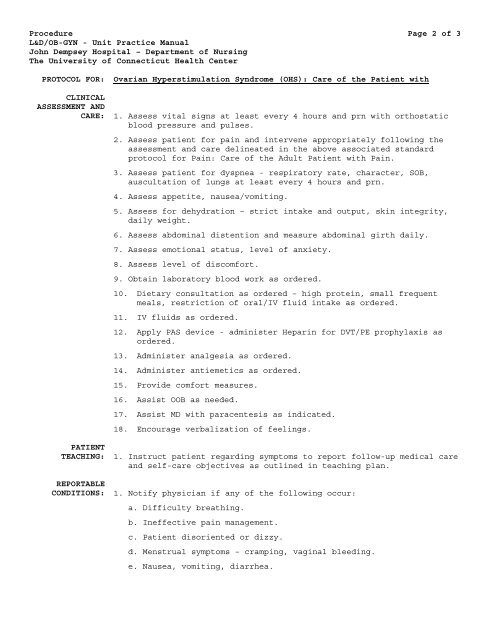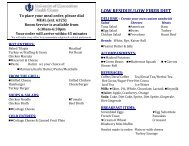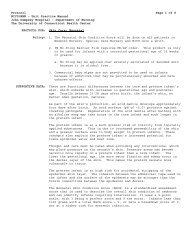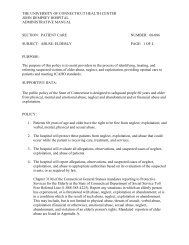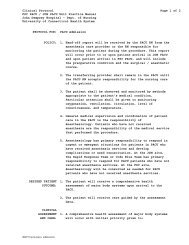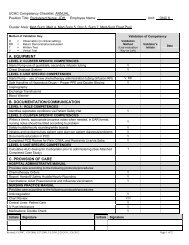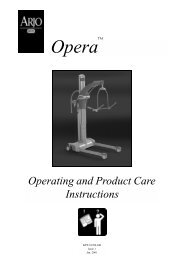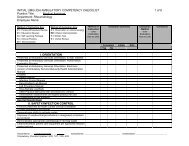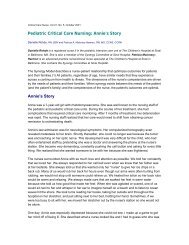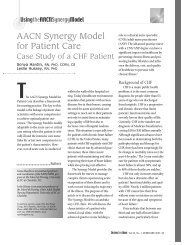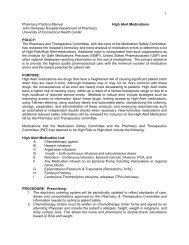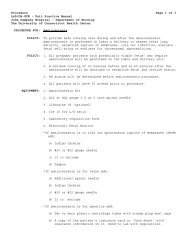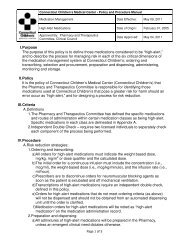Ovarian Hyperstimulation (OHSS): Care of the Patient with
Ovarian Hyperstimulation (OHSS): Care of the Patient with
Ovarian Hyperstimulation (OHSS): Care of the Patient with
You also want an ePaper? Increase the reach of your titles
YUMPU automatically turns print PDFs into web optimized ePapers that Google loves.
Procedure Page 2 <strong>of</strong> 3L&D/OB-GYN - Unit Practice ManualJohn Dempsey Hospital – Department <strong>of</strong> NursingThe University <strong>of</strong> Connecticut Health CenterPROTOCOL FOR: <strong>Ovarian</strong> <strong>Hyperstimulation</strong> Syndrome (OHS): <strong>Care</strong> <strong>of</strong> <strong>the</strong> <strong>Patient</strong> <strong>with</strong>CLINICALASSESSMENT ANDCARE: 1. Assess vital signs at least every 4 hours and prn <strong>with</strong> orthostaticblood pressure and pulses.2. Assess patient for pain and intervene appropriately following <strong>the</strong>assessment and care delineated in <strong>the</strong> above associated standardprotocol for Pain: <strong>Care</strong> <strong>of</strong> <strong>the</strong> Adult <strong>Patient</strong> <strong>with</strong> Pain.3. Assess patient for dyspnea - respiratory rate, character, SOB,auscultation <strong>of</strong> lungs at least every 4 hours and prn.4. Assess appetite, nausea/vomiting.5. Assess for dehydration – strict intake and output, skin integrity,daily weight.6. Assess abdominal distention and measure abdominal girth daily.7. Assess emotional status, level <strong>of</strong> anxiety.8. Assess level <strong>of</strong> discomfort.9. Obtain laboratory blood work as ordered.10. Dietary consultation as ordered – high protein, small frequentmeals, restriction <strong>of</strong> oral/IV fluid intake as ordered.11. IV fluids as ordered.12. Apply PAS device - administer Heparin for DVT/PE prophylaxis asordered.13. Administer analgesia as ordered.14. Administer antiemetics as ordered.15. Provide comfort measures.16. Assist OOB as needed.17. Assist MD <strong>with</strong> paracentesis as indicated.18. Encourage verbalization <strong>of</strong> feelings.PATIENTTEACHING: 1. Instruct patient regarding symptoms to report follow-up medical careand self-care objectives as outlined in teaching plan.REPORTABLECONDITIONS: 1. Notify physician if any <strong>of</strong> <strong>the</strong> following occur:a. Difficulty breathing.b. Ineffective pain management.c. <strong>Patient</strong> disoriented or dizzy.d. Menstrual symptoms – cramping, vaginal bleeding.e. Nausea, vomiting, diarrhea.


